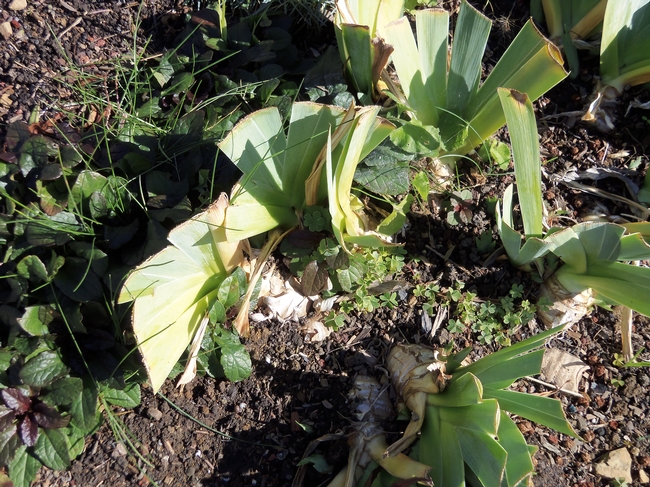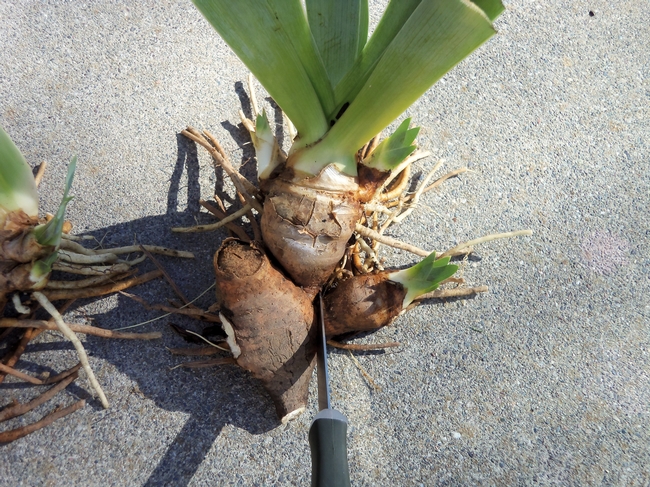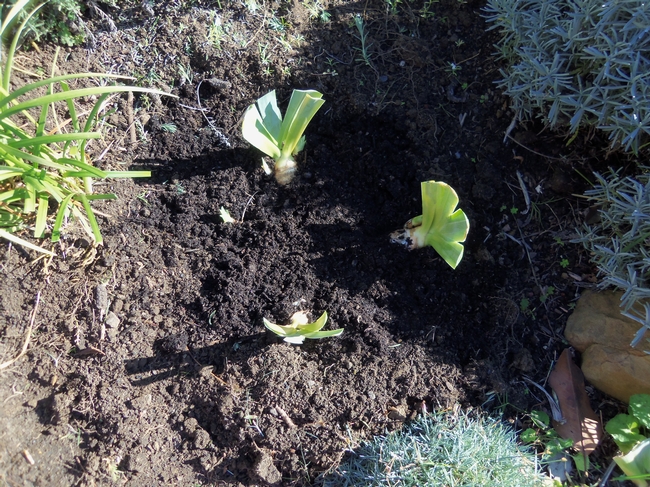UC Blogs
September Chores in October
It’s been fun to enjoy the warm weather so late in October and neglect my September garden chores. September is usually the time when you divide bearded iris that have been planted three or four years and have grown together. Irises have rhizomes or underground stems and propagated by division. You can share your favorite colors with friends or increase your favorite plants and flowers. There are just a few steps to follow.
- First, carefully dig out an entire clump out of the ground using a shovel or spading fork.
- Second, wash the soil off the roots and trim the leaves into a fan shape about 6 inches long. The roots should also be trimmed to about 6" long.
- Third, cut the healthy young outer rhizomes at the intersection points with a knife from the older thick plant. Discard the old rhizome and those without leaves. Make sure each section has at least one bud (eye) preferably several. Each rhizome is a distinct plant with its own leaves and root structure.
Replant the new divisions just below the soil surface in three to five plant groups. Irises grow outward from the fan of leaves, so the fan should face out of the circle to allow for growth. The soil should be kept moist but not too wet until the iris is established.
Let me hurry up and divide my irises and don’t forget to put plant your spring bulbs now!
Passing land and legacy on to the next generation
Passing family land from one generation to the next can pose emotional problems, financial problems and legal problems, noted a feature story in The Willits News. UC Cooperative Extension has been offering a series of succession planning workshops, titled "Ties to the Land," to help families deal with these issues.
”Family forests create many benefits through their stewardship actions, but the legacy can fall prey to the confusing details of land titles, permits, and inheritance if families have not crafted a succession plan,” said Bill Stewart, UC Cooperative Extension forestry specialist and organizer of the series. “This is especially true for owners who do not live in the county where their forest is. Their heirs have probably spent little time on the land, and the lack of shared goals can become a problem.”
With succession planning, land owners clarify their values and goals for the forest or ranch, determine their heirs' interest in the property, learn legal and business considerations, and understand the financial impacts of ownership transfers across generations.
Stink Bug on a Bee
When self-described "rock artist" Donna Billick of Davis created the morphologically correct honey bee sculpture for the Häagen-Dazs Honey Bee Haven...
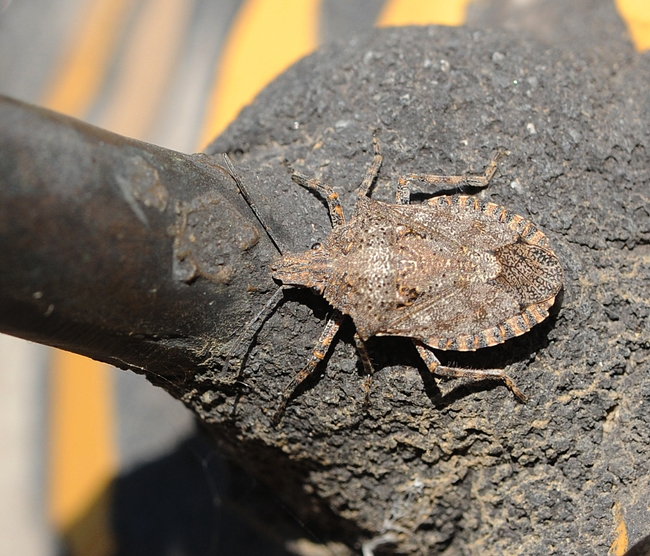
Consperse stink bug, Euschistus conspersus, crawls on the bee sculpture in the Haagen-Dazs Honey Bee Haven. (Photo by Kathy Keatley Garvey)
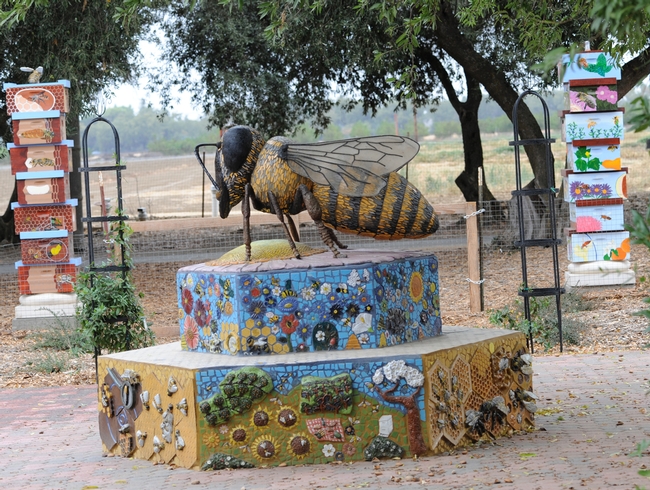
It's not visible in this photo, but there's a stink bug is on the left antenna of the "Miss Bee Haven" sculpture created by Donna Billick of Davis. (Photo by Kathy Keatley Garvey)
Burrrr!
Last night I was complaining to the husband about how cold it was in the house. I cranked up the heater, but it just didn't seem to do the trick. I hauled out a down blanket and put it on the bed. It didn't dawn on me until I opened the garage door this morning that Jack Frost had visited Dixon. The evidence was on all the roofs in my court-a light dusting of frost. I know this was a pretty isolated event, as I had queried a few Master Gardener friends from Fairfield. They said they didn't have any frost this morning.
Just a note to all you blog readers, protect your valuable plants or get them indoors. Watching the weather on the evening news might help. I would hate to see you lose that favorite plant due to a sneaky frost.
Farm advisor Allan Fulton a 'western innovator'
Capital Press writer Tim Hearden called UC Cooperative Extension farm advisor Allan Fulton a "western innovator" in a feature story about the 21-year UCCE veteran.
Fulton became interested in an agricultural career during childhood working on his grandfather's ranch in Colorado. He served as an irrigation farm advisor in Kings County for 9 years and, after a 4-year stint in private industry, joined Tehama County Cooperative Extension as the irrigation and water resources advisor 12 years ago.
Fulton publishes weekly soil moisture loss reports based on real-time regional weather conditions, helped develop the mathematical equation that allows growers to figure out how much water is needed for irrigation at a given time of year and visits farms to advise growers on their irrigation systems.
"In extension, it's a great opportunity to always be learning," he said. ". . . The biggest reward is when somebody hears of a new idea, puts it into use and is happy with the benefit from it."
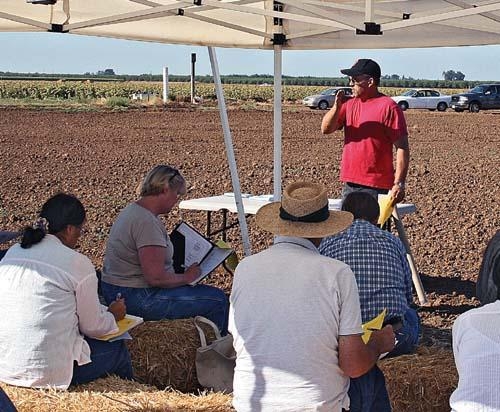
At a field day in Chico, Allan Fulton shares information on the different methods available for managing tailwater runoff from irrigated fields.


